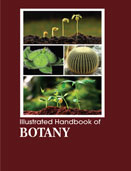Handbooks

Plants are vital to all life on earth. They convert light from the sun into energy we can eat, and even use for fuel. They also release the oxygen we breathe. Botanists study plants to try to understand how these processes work. Botany is the scientific study of plants. ?Plants,? to most people, means a wide range of living organisms from the smallest bacteria to the largest living things - the giant sequoia trees. Today scientists believe bacteria, algae and fungi are in their own distinct kingdoms, but most general botany courses, and most Botany Departments at colleges and universities, still teach about these groups. They may even study how genetic information in DNA controls plant development. This handbook provides a modern and comprehensive overview of the fundamentals of botany.
Botany is the branch of biology concerned with the scientific study of plants. Traditionally, botanists studied all organisms that were not generally regarded as animal. However, advances in our knowledge about the myriad forms of life, especially microbes, have led to spinning off from. Plants vary from a wide range of living organisms such as bacteria to the giant sequoia trees. By this criteria, plants include algae, lichens, ferns, fungi, mosses and plants that flower. Historically all living things were grouped as animals or plants, and botany covered all organisms not considered animals. Some organisms included in the field of botany are no longer considered to belong to the plant (plantae) kingdom, which obtain their energy via photosynthesis, ? these include bacteria (studied in bacteriology), fungi (mycology) including lichen-forming fungi (lichenology), non-chlorophyte algae (phycology) and viruses (virology). However, attention is still given to these groups by botanists, and fungi (including lichens), and photosynthetic protists are usually covered in introductory botany courses. The study of plants is vital because they are a fundamental part of life on Earth, which generates the oxygen, food, fibres, fuel and medicine that allow humans and other life forms to exist.
Illustrated Handbook of Botany provides a modern and comprehensive overview of the fundamentals of botany. Study of plants is equally important because it covers almost all animal life on Earth by generating a large proportion of oxygen that provides us and other organisms with aerobic respiration with the chemical energy that is essential to be alive. Cyanobacteria and Algae are the major groups of organisms that perform photosynthesis, which is a process that consumes the energy of sunlight to convert carbon dioxide and water into sugar that can be utilized both as a source of chemical energy and organic molecules that exist in structural components of cells. Plants liberate oxygen into the atmosphere as a by-product of photosynthesis, which is needed by all living things for cellular respiration. Also, they influence the global carbon, water cycles, and plant roots stabilize soils, that prevents soil erosion. All living things were organized as plants or animals previously, and botany encompasses the study of all organisms and does not include animals. Botanists test both the internal functions and processes within the organelles of plants, tissues and plants communities. At every level, botanists are concerned with the classification, evolution, phylogeny or function of plant life. The Illustrated Handbook of Botany brings to the reader a comprehensive coverage of how and why plants are so important in the world. Plants are crucial to the future of human society as they provide food, oxygen, beauty, medicine, habitat for animals, products for people, and create and preserve soil. It is believed that early in the Earth?s history, the evolution of photosynthetic plants altered the global atmosphere of the earth, changing the ancient atmosphere by oxidation. The book is suitable for the students and researchers in all areas of plant biology (structure, function, development, diversity, genetics, evolution, systematics), all levels of organization (molecular to ecosystem), and all plant groups and allied organisms.